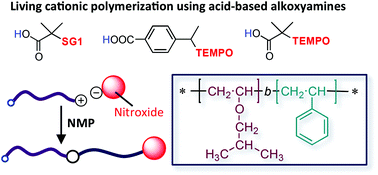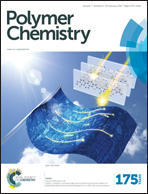A well-defined block copolymer synthesis via living cationic polymerization and nitroxide-mediated polymerization using carboxylic acid-based alkoxyamines as a dual initiator†
Abstract
A series of carboxylic acid-based alkoxyamines associated with SnBr4, a Lewis acid, have been used as protonic acids of a binary initiating system to control the cationic polymerization of vinyl ether. The living character of the homopolymerization of isobutyl vinyl ether was investigated under various conditions (solvent, amount of catalyst, initiator structure etc.). Among the different studied dual initiators, TEMPO based-alkoxyamine showed high efficiency to lead the polymerization of isobutyl vinyl ether (IBVE) in a controlled manner. The prepared polymers exhibited high TEMPO functionality (>0.85) and low dispersity (1.2) which is essential for the synthesis of well-defined block copolymers thereafter. TEMPO-functionalized PIBVE was used as a macro-initiator controller in the nitroxide-mediated polymerization (NMP) of styrene at 130 °C leading successfully to well-defined block copolymers of poly(isobutyl vinyl ether)-b-polystyrene (PIBVE-b-PS) with a narrow dispersity (1.2).


 Please wait while we load your content...
Please wait while we load your content...